35+ Surveillance Camera Trends and Statistics: Usage, Impact, & Risks
The first surveillance cameras were designed in the 1940s. Since then, they have become a mainstay of modern life, offering enhanced security and peace of mind to users the world over. In light of this growth, it’s time to examine the real statistics behind the camera lens. This article will examine all aspects of surveillance cameras, from their early development to modern use, with an eye on future use cases.
The future for the surveillance camera market is bright, though applications aren’t without controversy. This article covers all of that and more.
A Brief History of Surveillance Cameras
The history of surveillance cameras starts in the late nineteenth century, with the development of moving pictures. The technology developed in the early twentieth century with silent movies and the popularization of movie theaters by the likes of Charlie Chaplin, Buster Keaton, and Greta Garbo.
During the Second World War, Germany used the technology to create a closed-circuit television (CCTV) system to safely observe the launch of V-2 rockets. Later, the US military used a similar CCTV system to observe the detonation of atomic bombs. These systems, while advanced for their time, were unable to record what they viewed.
The technology was quickly adopted for remote monitoring, mostly in industries that could afford to employ the personnel needed to monitor the video feed. Recording systems weren’t developed until 1956, and they were prohibitively expensive, at $50,000.
Videocassettes, developed in 1969, made CCTV surveillance practical and affordable. Marie van Brittan Brown’s first patent for a home security system similar to what we still use today was granted in 1969. The device enabled the user to see, record, and speak to someone at the front door.
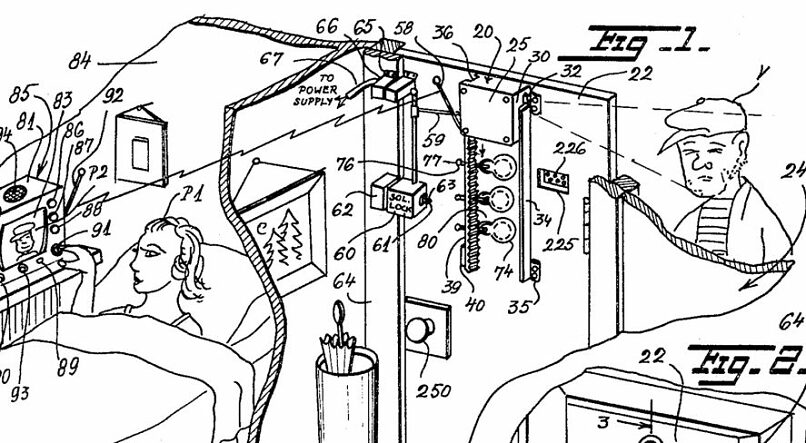 Marie van Brittan Brown’s patent drawing for her home security system, courtesy of USPTO
Marie van Brittan Brown’s patent drawing for her home security system, courtesy of USPTO
From there, each decade has seen advancements in technology, beginning with continual recording and simultaneous camera monitoring through to the introduction of the first IP cameras in the 1990s.
The turn of the millennium ushered in a new style of camera with high-speed internet connections and network technology, including cloud storage and the ability to view footage remotely. High definition and advanced analytics soon followed, along with advancements in artificial intelligence, including facial recognition, that are setting a new baseline for CCTV and home surveillance capabilities.
The current generation of surveillance cameras includes machine learning technologies and connectivity to the Internet of Things, offering the same robustness of surveillance in the home as is available on a commercial level.
Section 1: Market and General Data
Surveillance cameras are now ubiquitous, from highways and main streets to school campuses and family homes, offering a combination of security and peace of mind.
The surveillance sector has grown tremendously since its inception and is now a multi-billion-dollar industry. The following collection of statistics dives deep into the surveillance market and examines its global growth.
1. CCTV Market Forecasted to Grow Through 2029
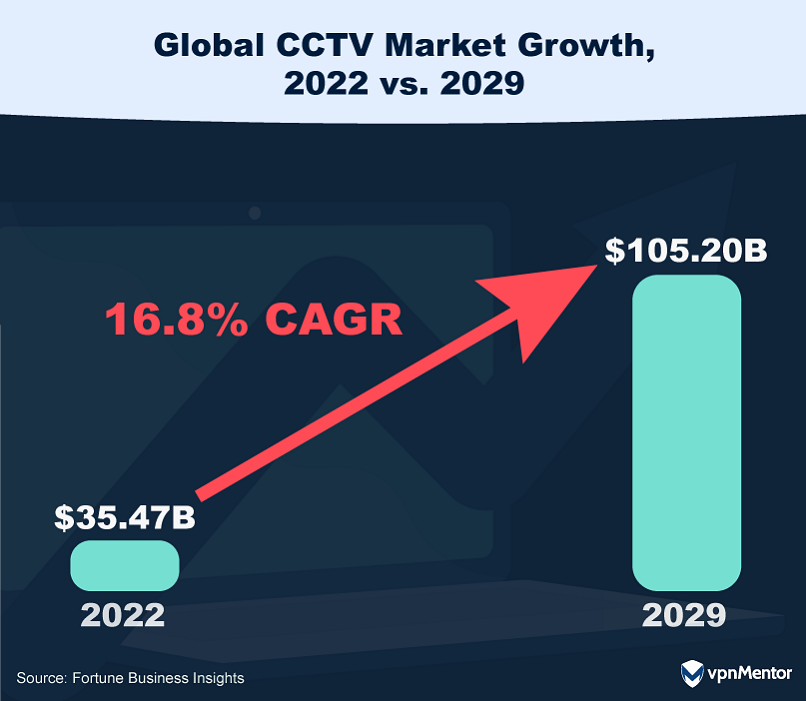
In recent years, several prominent names such as Axis and Hikvision have invested heavily in advanced technology, breathing renewed interest in the sector. In 2022, the global value of the CCTV niche dipped to $35.47 billion due to a 4.6% drop caused by COVID-19. Market forecasts indicate solid growth to $105.20 billion by 2029, with a CAGR of 16.8%, the majority of which is driven by the dominance of Internet Protocol (IP) cameras.
2. Home Security Market Set to Grow Between 2020 – 2030
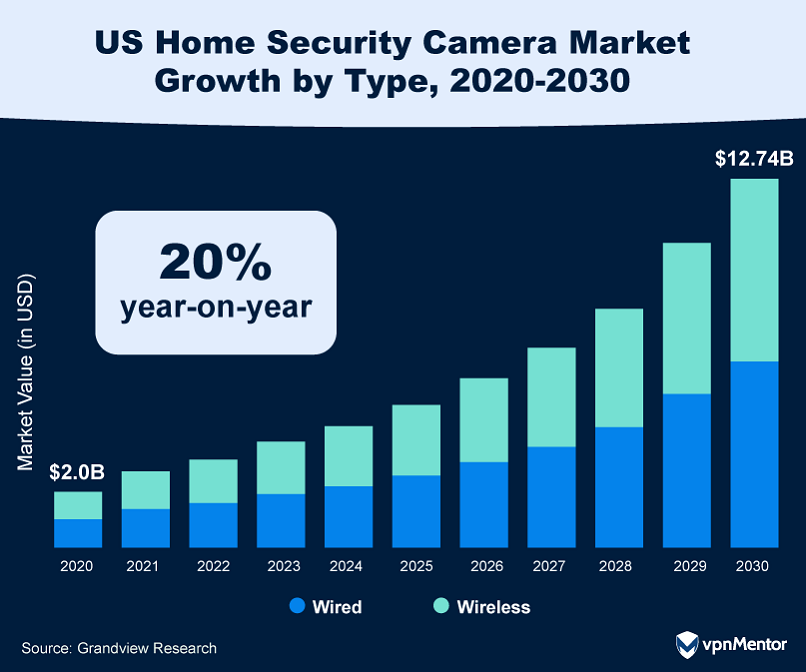
Smart home technology is a booming market, and home security cameras are leading the charge. The market forecast for smart home security cameras shows a 20% year-on-year increase through 2030, rising from $2 billion in 2020 to $12.74 billion.
One reason is the growth in the market of younger, more security-conscious, tech-savvy people buying or renting their first homes. The forecast also shows a sustained even split between wired and wireless cameras.
3. The Global Dashcam Market Growing Year-on-Year

Dashboard cameras became popular in the twenties. Since then, the market has grown rapidly, with a 6-year forecasted CAGR of 9.6% through 2030, when the market share will exceed $7.64 billion.
While protection against theft is a key factor behind the predicted growth, other considerations include protection against fraud and monitoring driving patterns. Dashboard cameras provide evidence against staged accidents and other false accusations, can record theft or vandalism attempts even when a car is stationary, and can be used to challenge moving violations.
Many European car insurance firms now accept dashcam footage as evidence; consequently, Europe holds a 45% share in the dashcam market.
4. China’s Hikvision Is the Leading Surveillance Manufacturer in the World

Hikvision is the most popular brand of security camera in the world. A Chinese manufacturer, it offers a wide range of camera types for various markets, including commercial, residential, industrial, and even dashboard cameras.
Hikvision is not highly rated in the United States. This is likely due in part to the National Defense Authorization Act (NDAA). Hikvision cameras are not certified by the NDAA and, therefore, cannot be used in US government buildings or by entities working on US government contracts.
5. More Security Cameras Have Infrared Capabilities

Security cameras have a range of capabilities, the most popular of which is infrared technology. Currently, roughly 45% of all active cameras have infrared capabilities; users want the ability to capture clear images in low-light settings.
Furthermore, recent developments such as thermal imaging and infrared fusion have created deeper interest in these cameras. These technologies are especially useful for external perimeter protection.
6. Indoor Cameras Are Preferred for Home Security

Data published by Grand View Research revealed that indoor security cameras hold slightly more market share than doorbell or outdoor cameras.
While home security cameras act as a crime deterrent and security measure, modern cameras offer capabilities such as instant SMS alerts from camera activations, which can help deter theft and burglaries. Movement and behavior recognition alerts make them convenient monitoring systems for pets, children, and babysitters.
7. Most Low-Light Camera Clients Want Color Imaging
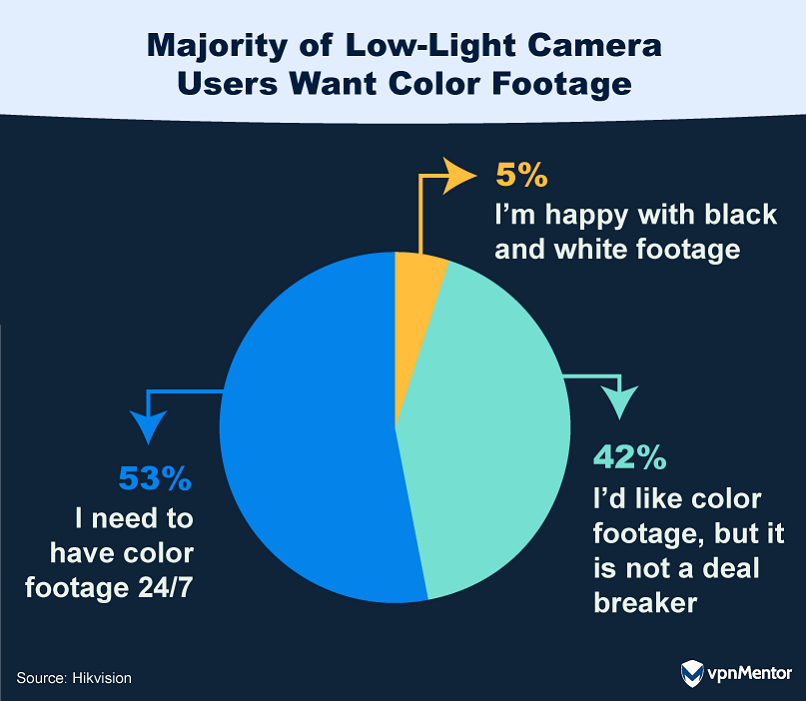
One of the core features that operators of low-light cameras want is color imaging, with 95% of operators finding it a good idea and 53% viewing it as essential.
As the name suggests, low-light cameras are commonly used during times of poor light, such as dawn and dusk. The incorporation of color imaging sensors helps to maintain visibility while also enabling sharp, clear images.
8. Pan-Tilt-Zoom Cameras Have a Smaller Field of View but Cover a Larger Area
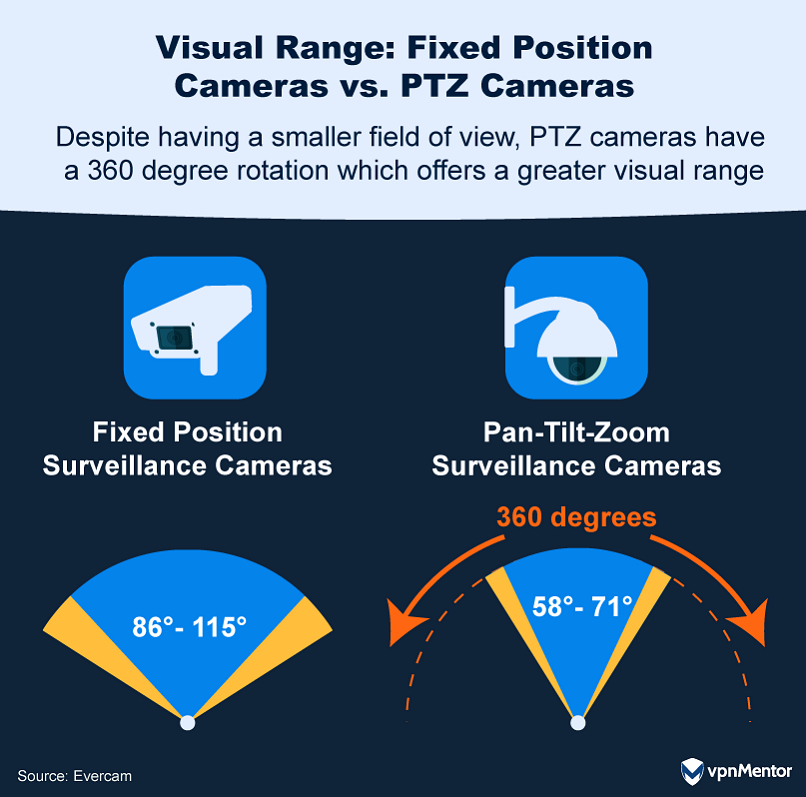
There are two core types of surveillance cameras: fixed-position and Pan-tilt-zoom (PTZ). Fixed-position cameras offer a greater field of view, up to 115 degrees, making them preferred for use in static locations such as corridors and doorways. They are also lower-cost and easy to maintain. However, larger areas will require multiple cameras.
Pan-tilt-zoom (PTZ) cameras offer a reduced field of view at just 71 degrees but can rotate 360 degrees. This means that PTZ cameras offer better coverage for large areas, such as shopping centers and sports stadiums. However, they need time to move into a new position before offering a live video feed.
9. IP-Enabled Cameras Are Popular
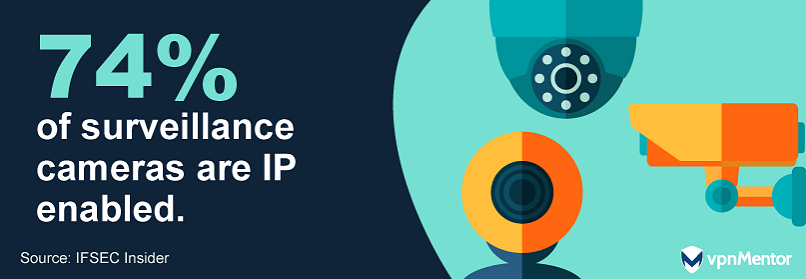
When talking about data storage, there are two core surveillance camera options: analog and digital Internet Protocol (IP) cameras.
A recent report confirms that 74% of operational CCTV and surveillance cameras are currently IP enabled, which means they store their recordings digitally either on a local server or, for more modern cameras, in the cloud. The same report confirmed that over thirty percent of CCTV users operate 100% IP-enable systems. Many of the remaining analog systems are believed to be legacy systems that operate sufficiently enough that the cost of upgrades can’t be justified.
10. Value of Facial Recognition Technology Expected to Rise Through 2025
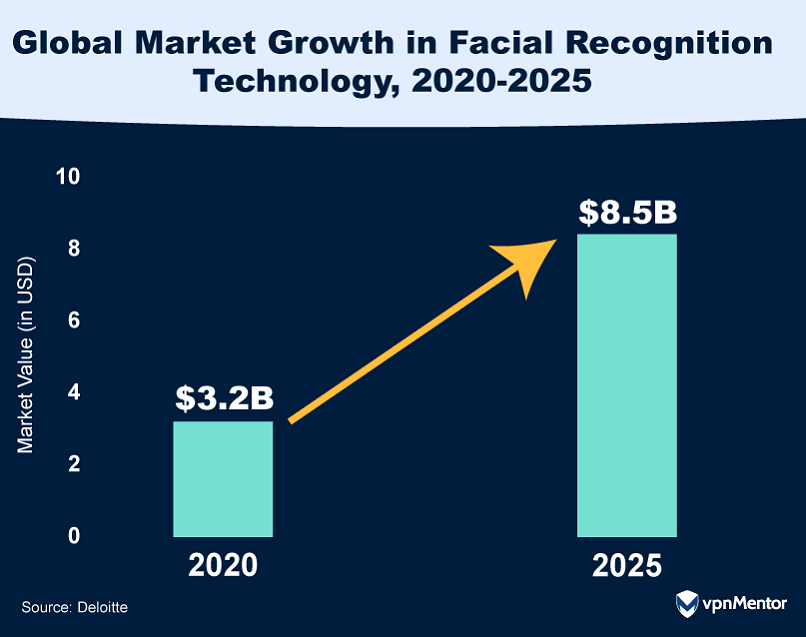
Research into facial recognition began in the mid-1960s, and the technology has since grown into a global commodity. Reports forecast that between 2020 and 2025, the market value of facial recognition technology will grow by 165.63% to $8.5 billion.
The rate of technological advancement and big-name investment in tech are driving forces behind the sustained growth. Most facial recognition software currently scans faces against eighty different facial elements (called “nodal points) for enhanced scan accuracy.
11. More Surveillance Cameras Are Upgrading to Edge-Based Technology

Almost half of all video surveillance camera users are upgrading or installing edge-based technology, an advancement that allows information to be processed and analyzed on or very near the camera. This speeds up analysis time and eliminates the need for data retrieval and third-party involvement.
Currently, 30% of network-based cameras offer edge-based capabilities. However, this is forecast to reach 70% by 2026. As the technology becomes more commonplace, its costs are expected to decrease, which is expected to keep adoption rates high.
Section 2: Usage and Adoption Statistics
As surveillance technology continues to be updated to meet consumer needs, adoption rates increase. The Internet of Things being accepted inside homes brings new levels of interconnectivity between devices, making it even easier to own and operate security devices like video doorbells.
People want to feel safe in their own homes, which is driving residential surveillance camera use. However, despite the heavy residential adoption, the core areas that use surveillance cameras remain infrastructure, commercial buildings, and schools.
12. Many Small Business Owners Installed or Upgraded Cameras in 2023

The majority of small-to-medium (SMB) retail businesses installed or upgraded security cameras in 2023. The primary reason for businesses adopting stricter surveillance measures lies in their need to combat increasing shrink rates. Shrink is the loss of inventory through theft, damages, and administrative errors. According to the National Retail Federation, non-employee-related theft accounts for around 36% of shrink.
Around 68% of small retail businesses said their shrink rate increased following the COVID-19 lockdowns. More recently, financial pressures have risen as global inflation hit many families hard. This has caused 88% of small businesses to say that combatting shrink is a priority.
13. Small Business Owners Willing to Pay for Good Surveillance

Installing surveillance cameras comes with costs many small business owners are willing to pay. A typical small business requires around $3,000 to install a security camera, with additional monthly costs of up to $120 for third-party monitoring.
The average retail industry shrinkage is around 1.5%. For many small retail business owners, the initial outlay and ongoing costs associated with surveillance cameras are recouped in lowered insurance premiums and reduced theft due to deterrence. While cameras may not stop a determined thief, they can make thieves decide to look for easier targets.
14. Increased Security Camera Monitoring in Schools

Violence in schools is as undeniable as it is tragic. Everybody, from parents and students to teachers and board members, wants to know that their school is a safe place.
Real-time surveillance is being adopted in schools at increasing rates, with a 30% increase in the number of school campuses covered by video surveillance between 2009 and 2019. During the same time, the victimization rate at schools fell from 51 to 30 cases out of 1,000. While this change can’t be attributed to surveillance alone, it does suggest that cameras are part of a positive change in school safety.
The market value of school and campus surveillance is forecast to grow by 319%, reaching a net worth of $12.58 billion by 2032.
15. The Majority of US Police Departments Use CCTV Surveillance

CCTV is marketed as a tool for keeping streets safer. Particularly prominent in areas known for a higher crime rate, footage caught by these cameras can be invaluable in solving crimes.
Reports have shown that in jurisdictions with over 250,000 inhabitants, 87% of law enforcement departments invest in CCTV technology. However, in smaller jurisdictions, the number drops to less than fifty percent.
16. Police Worn Body Cameras Are a Cost-Effective Solution
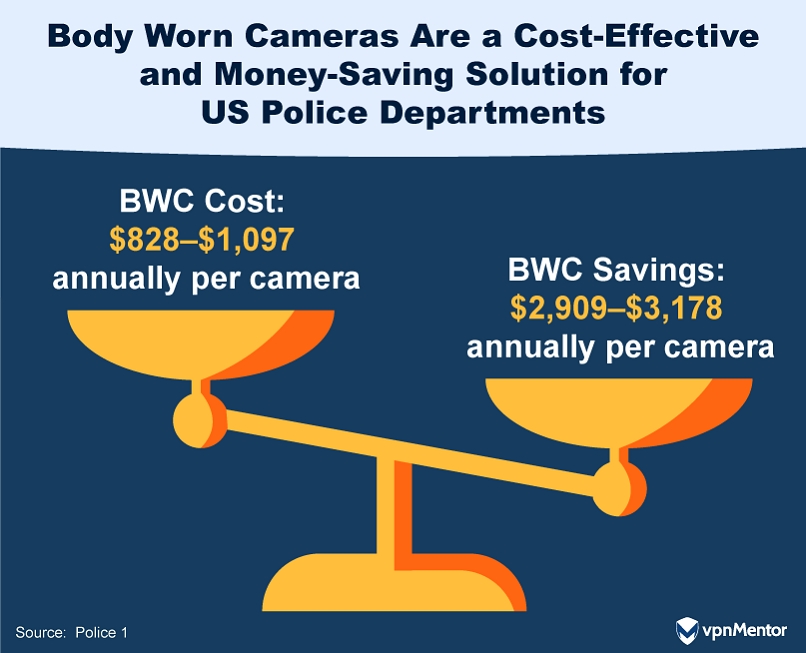
Police-worn body cameras are found to save around $3000 per year per officer while costing only about $1000 per camera to implement.
Studies show that the number of complaints of abuse of authority decreases when officers wear body cameras. Additionally, the presence of video evidence helps to ensure that any complaints are resolved on a reduced timescale, offering further departmental savings.
17. The Majority of Police Officers Want to Wear Body Cameras

A study by the Pew Research Institute found that 82% of police officers favor being issued individual body cameras. Two-thirds of officers favor the use of body-worn cameras when interacting with the public.
Body-worn cameras increase transparency surrounding police operations and interactions, capturing both police behaviors and the reciprocated interaction from members of the public. Half of the police officers surveyed felt that an officer would be more likely to act professionally when wearing a camera.
18. Officers Slow to Activate Body Cameras During Use-of-Force Incidents

Many departments have policies stating that cameras should always be worn while in the field and activated when an interaction with the public is likely. However, they are not constantly recording.
A recent finding among LAPD officers found that while 96.3% of officers had been involved in a use-of-force incident, around 20% were slow to activate their body cameras in a direct breach of the LAPD usage policy.
In 13% of the evaluated cases that formed the report from the Office of the Inspector General, officers failed to activate the recording on their body cameras.
19. Video Doorbells Popular in Conjunction with Other Security System Technologies
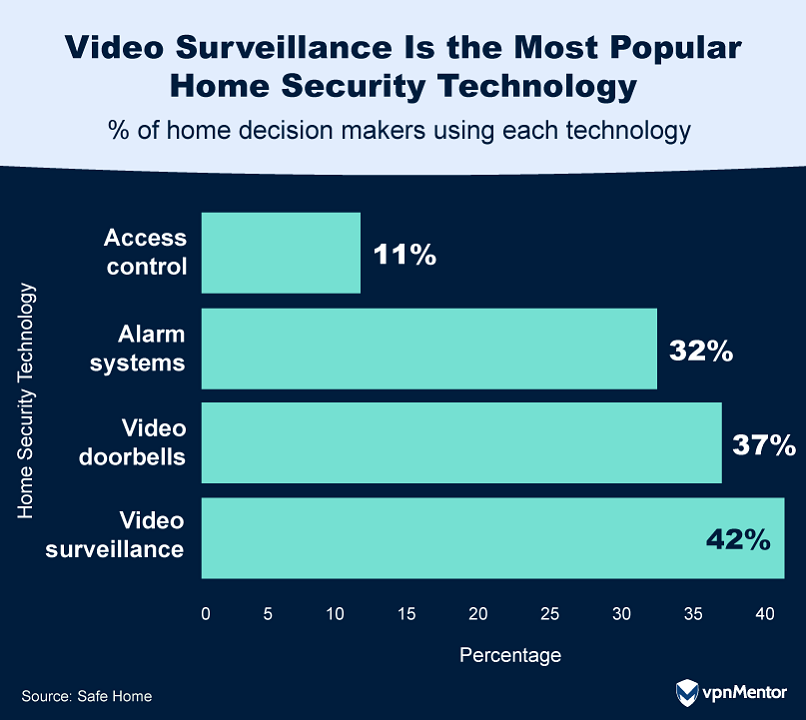
Many homeowners and home decision-makers use some form of home security technology to keep their homes safe. Video surveillance cameras and video doorbells are the most popular options.
A survey found that 37% of decision-makers in homes without a video doorbell planned to purchase one in the next year. The combination of internal cameras and doorbell cameras offers a broad spectrum of surveillance coverage, with 29% of home surveillance camera users using their cameras and video doorbells to keep an eye on their kids and pets when they are not home.
20. More Countries Are Adopting Facial Recognition Systems
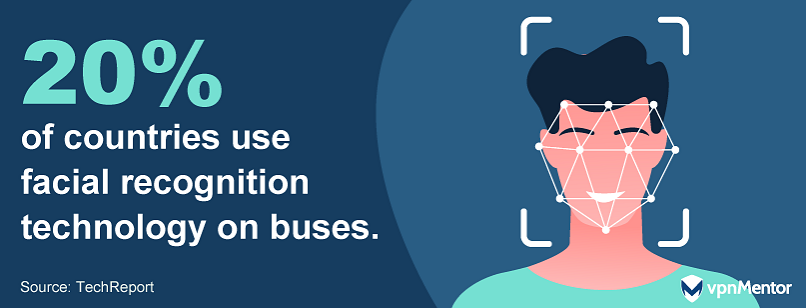
Data compiled in 2022 examined 99 countries and revealed that facial recognition technology is currently used by 80% of governments and on a large-scale basis in 70% of countries.
The use of technology extends beyond governments and is being used by more and more industries on a daily basis. The same data report revealed that facial recognition is used by 30% of countries on trains and subways.
Of the 99 countries researched, only Belgium and Luxembourg had banned the use of facial recognition technology.
21. China Has Approximately One Surveillance Camera for Every Two People
China has the most CCTV cameras installed in the world. With 626 million CCTV cameras for 1.43 billion people, China’s ratio of one camera for every two inhabitants is five times greater than the next country on the list.
This is driven by several factors, including the size of the country, the sheer number of inhabitants, and active efforts to reduce crime. At the same time, many critics feel the cameras facilitate the government’s overly firm social control, and their use is viewed as being politically motivated.
Section 3: Statistics on Impact and Public Opinion
Surveillance cameras have had an impact in all areas where they are in use, from lowering insurance premiums and increasing home prices to helping police solve crime.
However, the technology also has its detractors, who point to the controversiality surrounding the loss of privacy and the potential for government abuse.
22. Home Insurance Discounts Available for Those with Home Security Systems

Home security systems, including surveillance cameras and video doorbells, can reduce the cost of home ownership. Many insurance companies offer reduced insurance premiums for homes with security systems. Almost a third of homeowners and renters are offered discounted premiums by their insurance companies. This is driven by the fact that homes with no home security systems are 300% more likely to be burglarized.
23. Home Surveillance Cameras Shown to Increase Property Values

Another often overlooked benefit of having surveillance cameras installed at a property is their positive impact on property value. In the United Kingdom, homes in Durham saw their value increase by as much as £18,900.
The increase in house prices is strongly linked to localized crime rates. Durham saw the highest rise in house prices as a result of surveillance camera installation and also has the highest crime rate of the areas surveyed. Similarly, York had the lowest crime rate, and the use of cameras barely impacted house prices, with just a £100 change in value.
24. Surveillance Cameras Not Effective at Reducing Violent Crime

Data taken from Lincoln, Nebraska, found that surveillance cameras had no impact in reducing the number of violent crimes committed within their line of sight. Data showed that 128 assaults occurred within 500 feet of the installed surveillance cameras. The same study found that the cameras were also not effective as a means of suspect identification.
Another study in Baltimore, conducted by the Urban Institute, found that the introduction of 500 cameras reduced 30 incidents per month. Taken together, these two samples show that crime prevention and deterrence are complex and have no single solution.
25. Home Video Surveillance Catches Porch Pirates
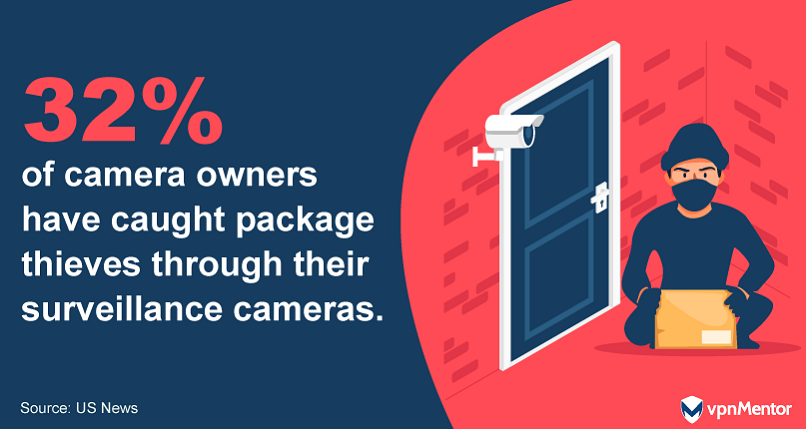
Porch piracy resulted in stolen goods worth over $8 billion in 2023. With a median value of $50, that equates to a lot of stolen packages. In fact, in October 2023, 17% of Americans reported having a package stolen within the previous three months. Not taken into account is the fact that one in seven porch thefts are never reported to the police.
Video doorbells are beginning to prove effective porch piracy mitigation tools, with 32% of camera owners having caught package thieves.
26. Americans Remain Skeptical About Doorbell Cameras
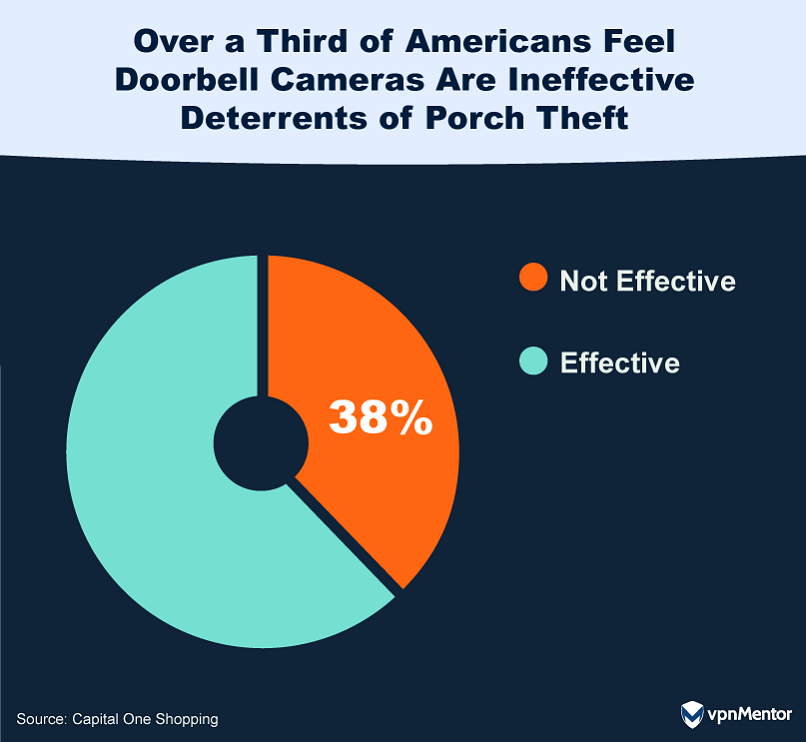
In the US, only 20% of homeowners have a doorbell camera installed. A recent study revealed that 38% of consumers were skeptical of a doorbell camera’s ability to deter package theft. Yet, 65% of video doorbell camera owners were very satisfied with their product.
A video doorbell’s intended use is not only deterring theft. It also provides oversight of the property while owners are away and allows operators to communicate with delivery drivers to ensure packages are left in a safe space.
27. Trust in Facial Recognition Surveillance Is Linked to Accuracy
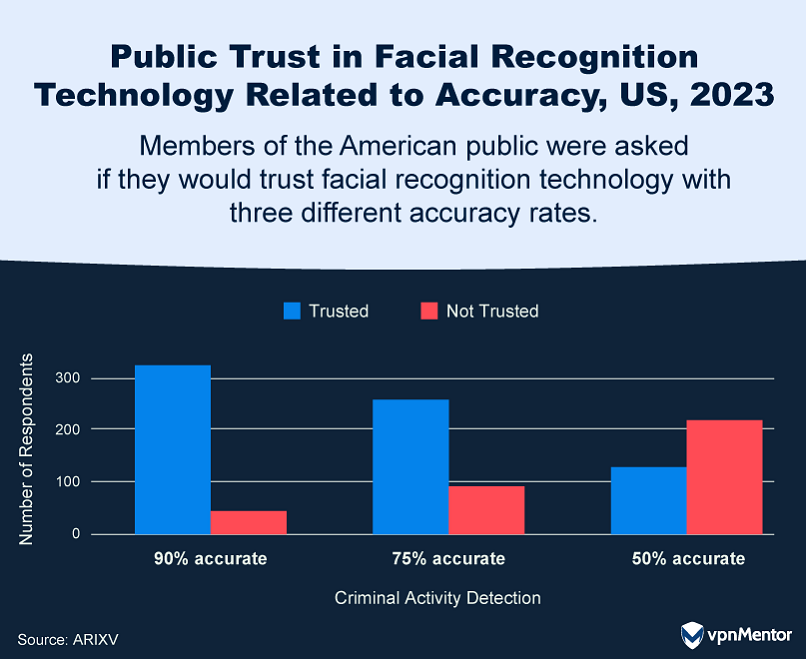
Public perception of facial recognition software correlates strongly with its accuracy. Once facial recognition accuracy passes 50%, public opinion begins to sway. Once the technology reaches 75% accuracy, the public’s trust far outweighs their distrust. This trend continues as algorithms become increasingly accurate.
A second survey conducted by the PEW Research Center revealed that 57% of Americans did not believe that facial recognition would have an impact on crime rates. While 33% thought the technology would reduce crime rates, it raises an interesting discussion as to whether facial recognition is a greater preventative measure or investigative tool.
28. Non-White Individuals Are Far More Likely to Be Misidentified by AI Surveillance

Recent studies from the National Institute of Standards and Technology have shown that people of African and Asian descent are between 10 and 100 times more likely to be misidentified by AI facial recognition technology.
The same report found that the most frequent cases of misidentification were in US-made algorithms; Asian-made systems returned far fewer false identifications between Caucasian and Asian people. These reports suggest that AI surveillance accuracy is linked to the diversity of data used to train it.
The unreliability of AI surveillance is evident in cases such as Robert Williams’s 2020 wrongful arrest. In the resulting lawsuit, Williams sued the Detroit police force, which was banned from making arrests solely based on AI surveillance.
29. Americans Not in Favor of Government-Installed In-Home Surveillance
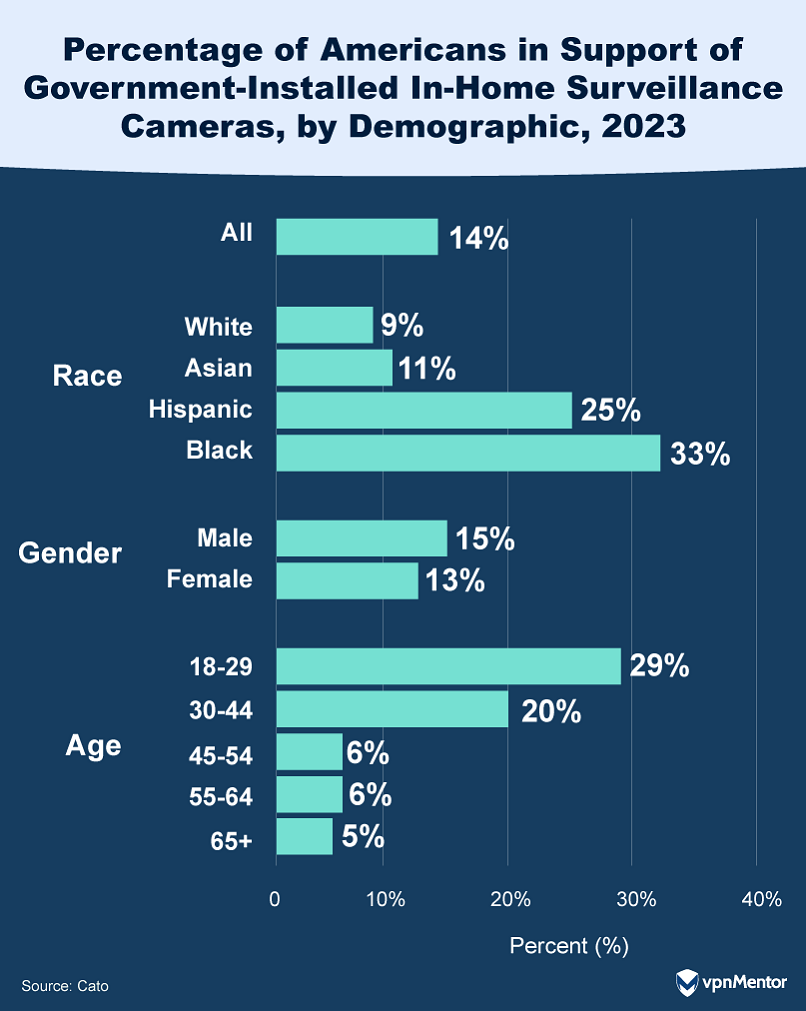
Elective personal home surveillance cameras are a rapidly growing commodity. However, the public’s view of government-installed home surveillance is a different story. Only 14% of Americans surveyed were in favor of in-home government surveillance cameras.
The largest groups in favor of government surveillance in their homes were 18 to 29-year-olds and those from African American and Hispanic backgrounds. In general, there was a far larger consensus among younger generations that government surveillance was a good thing than among older citizens.
30. 70% of UK Shoppers Distrust How Retail Companies Would Use Facial Recognition Technology

A 2019 study regarding the use of facial recognition software in the UK revealed that while 63% of the public were in favor of its use in police and criminal investigations, the vast majority were against it being used to track activity in the commercial sector.
The study revealed that 77% of UK shoppers were uncomfortable with facial recognition software being used in stores, and 70% of those were distrusting of the relevant companies’ ethical intentions on what to do with the data. Similar levels of distrust exist surrounding recruitment, with 63% of individuals concerned about the ethical use of the technology.
31. CCTV Shown to Reduce Car Crime in Areas Where It’s Installed
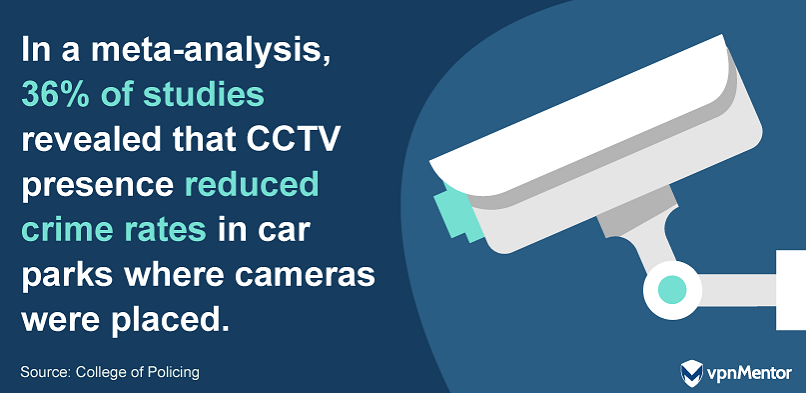
A meta-analysis of studies done over 40 years on the impact of CCTV surveillance on crime rates revealed that car crime showed the most consistent reduction in offenses. Across all of the studies reviewed, car crime showed an average reduction of 37% in areas where CCTV was used, compared to a 12% average reduction in other residential areas.
The meta-analysis did not see a reduction in violent crimes. In six studies, cameras were shown to displace crime rather than prevent it, with criminals moving to areas where fewer or no surveillance cameras were operational.
32. Surveillance Camera Use Offers Inconclusive Rates of Displacement and Diffusion

The same 40-year meta-analysis looked at the rates of displacement and diffusion in relation to surveillance camera use in a range of settings. The results show the impact on crime levels was statistically significant but modest, with limited evidence to support clear patterns of displacement (where crime moves to other areas) or diffusion (where the benefits extend to nearby areas).
In city centers, 26% of the studies reported evidence of diffusion. However, the majority of studies showed no statistically significant impact on crime rates. Similarly, in residential areas, diffusion was observed in 36% of studies compared to 9% showing evidence of displacement. The majority of studies in this setting (55%) showed no evidence of either effect.
The data on housing complexes was even less definitive. The 6 studies reviewed found no substantial evidence to support either displacement or diffusion, despite 20% of the studies showing a decrease in crime rates.
The evidence on public transport was equally divided, with a 50/50 split noted between displacement and diffusion across two studies.
Overall, across different contexts, the data suggests that cameras may be most effective at preventing property crime and may supplement the efforts to prevent other crimes, but they may be ineffective as a stand-alone measure.
Section 4: Legal and Ethical Considerations
The legal and ethical considerations of surveillance cameras are subject to long-standing debate. The use of surveillance cameras, especially in the public sphere, raises important legal and ethical considerations. While surveillance cameras have been shown to deter some types of crime, they expose users to the risks of hacking and government surveillance.
In this section, we look at some of the key debates
33. Spying Concerns Among American Home Surveillance Camera Users
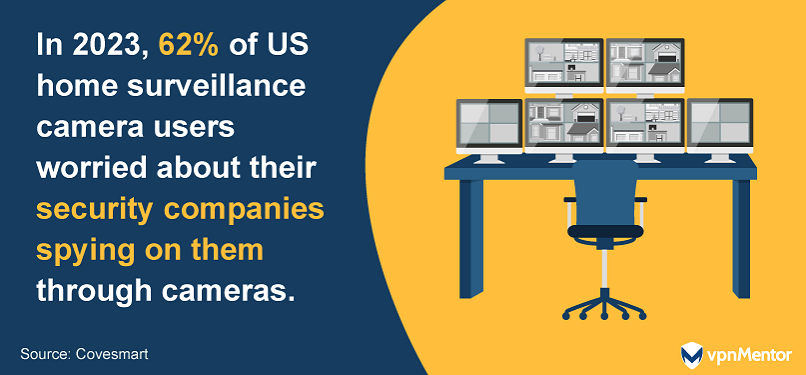
While the vast majority (86%) believe that home video surveillance is beneficial for security, a 2023 report from Covesmart revealed that many people also fear that their security providers will use the systems to spy on them.
As people become more tech-savvy, they also become more conscious of the dangers that come with the benefits of welcoming advanced technology into the home. Almost two-thirds of people are worried about the potential dangers of having IP cameras set up in their homes, especially when using third-party companies to monitor and store their footage.
34. Chinese Public Uncomfortable with Government Surveillance

Surveys conducted in China revealed a relatively even split between the levels of surveillance people reported as acceptable, from government tracking of internet use and conversations to physical movements. A fractional majority reported being against such close levels of tracking.
A 2023 report from the Australian Strategic Policy Institute revealed that 85.1% of people living in China reported being happy that the local government installed facial recognition technology in apartment complexes. However, within that, 51.9% of people placed the caveat that camera usage should be voluntary. The study did not reveal how many of those people would actually give their consent to the surveillance.
35. Security Cameras Are a Potential Hacking Risk
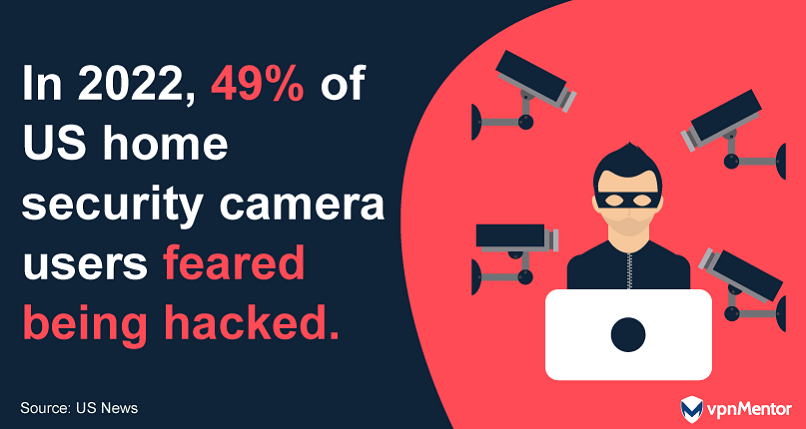
49% of American home surveillance camera users worry about hacking, which can, in some instances, reduce their sense of trust and security in their home surveillance.
People are more alert to the dangers presented by technology and IP cameras, with 13% already being victims of security camera hacking. This number is likely to be higher as it does not count the incidents that have gone unnoticed or unreported.
As a result, 52% of camera operators have taken varying measures to protect themselves and stop hackers from accessing their surveillance systems. These measures include two-factor authentication, ensuring firmware updates are carried out, and using more secure passwords with no duplication across multiple devices.
36. In 2023, Almost All US-Sold IP Cameras Were NDAA Compliant
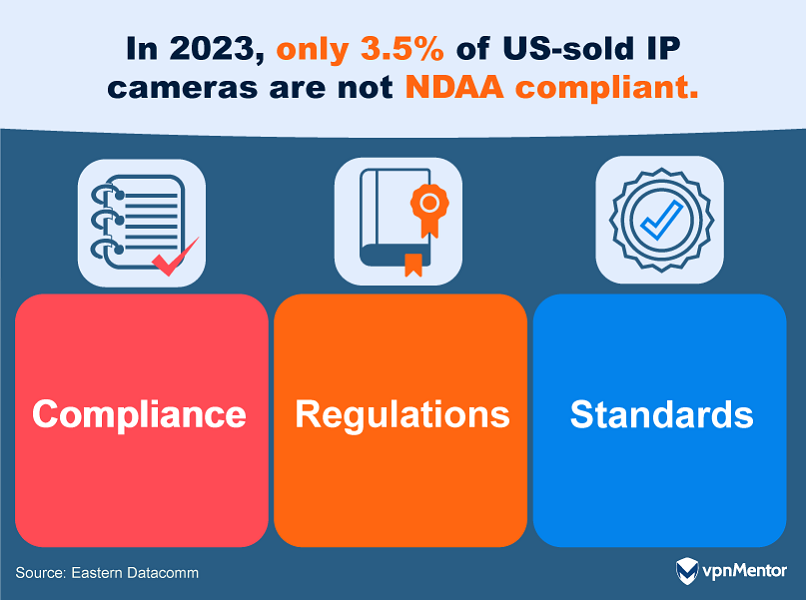
Regulatory compliance is important for companies to manage in the surveillance video camera niche. In 2019, America amended the National Defense Authorization Act by passing section 899, which prohibited the use of components from banned manufacturers.
This push came as part of an effort to reduce perceived threats to national security. It was feared that cameras operated with Chinese-manufactured chipsets provided a backdoor that could be exposed for malicious purposes. The crackdown resulted in 20% of camera manufacturers permitted in 2019 being banned from sale in the US in 2024.
While non-NDAA cameras are still available for sale and are considerably cheaper than compliant models, just 3.5% of active cameras sold in the US breach NDAA compliance.
The Bottom Line
The surveillance camera market is booming, and forecasts predict a market value of $105.20 billion in 2029. It is not showing any signs of slowing down. The continued use and implementation of security cameras in public and private settings continue to blur the line between privacy protection and security supplementation.
The shifting consensus toward surveillance cameras is largely due to the younger demographic’s increasingly safety-conscious attitude and the willingness to make some sacrifices in their privacy to feel safe.
Surveillance cameras have been around for over sixty years, and they are not going to disappear. However, as they become increasingly ubiquitous, societies need to work to ensure appropriate regulations regarding their use, including the proper development and deployment of AI tools.
React to this headline: